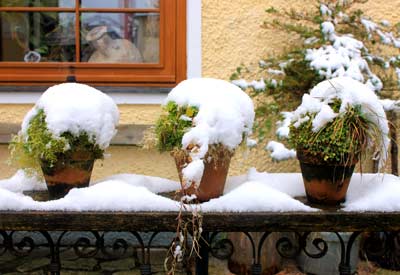Those of us who use potted plants in our gardens, on our patios, and around our landscapes face a problem each winter: how to protect them during the long cold winter. It’s hard enough in areas where extreme cold is frequent to keep perennials in the ground alive. It’s much harder overwintering potted plants. The bulk of soil that is in the ground tends to moderate the temperatures. The small amount in pots tend to give up heat more readily. What to do?
The general rule of keeping plants in pots two zones different than the zone you live in helps. In other words, if you live in zone 6, make sure the plants you have in containers are rated to zone 4. This of course makes it difficult if you live in zone 4. There are other things you can do to carry over plants in winter. Here are some suggestions. The basic rules are, of course, to keep the soil in the pots from freezing solid and becoming totally dry; not an easy proposition.

SUPPORTS 500 LBS!
Rolling Plant Stands
Use indoors or out to move and rotate heavy plants -- supports up to 500 lbs.
$29.95Learn moreGrowing in containers is easy with the right equipment. At Planet Natural we have the gardening supplies you need — pots, soils and tools — to be successful. Now, let’s grow!
First check your pots. Make sure there’s no place for water to collect on the soil surface where it can freeze and thaw and freeze again. This is particularly damaging to perennials. Good drainage is important and fluffy soil also adds a measure of insulation.
Best is to move them indoors wherever there is room. This could mean a garage, a basement or a greenhouse if you have one. An unheated garage will moderate outdoor temperatures and give your plants a good chance at survival. Covering them with tarps after insulating them with rolled newspaper or cardboard may give you the two or three degree warmth that might mean the difference between survival and freezing. Basements, if heated, pose another problem. They might be too warm. That’s fine if you’re overwintering geraniums or another plant that will continue to thrive in their pots over the cold season (don’t forget to make sure your plants have adequate light). But some might be fooled into thinking its spring and be “shocked” when replanted outside.
No room inside? Or are your pots too big to move easily? Consider sticking the plants in the ground. Again, ground temperature fluctuations tend to moderate. Containers — even the largest — tend to be more susceptible to freezing. Digging your plants up from their containers in the fall after trimming back their top growth and burying them deeply — with several inches of mulch and soil over the top — will increase their chances of survival. Smaller pots can be buried in larger pots. We knew one gardener who placed his trimmed-back potted plants in a trench, pot and all, come fall. This seemed extreme to us, especially when we helped dig them up in the spring. Needless to say, at least one pot was broken in the process and the whole operation seemed more trouble than it was worth.
Protecting trees, shrubs, and other woody potted plants that don’t take to trimming back requires extra care. Wrap delicate trunks with burlap starting at the soil line and continuing as high up as possible. Heaping leaves and mulch around these pots, using chicken wire or other fencing to hold it up and around the pot will also significantly increase survival chances.

Like real estate, location can be crucial to the success of overwintering your potted plants. Placing them against a south-facing wall or near the side of the house may give them just the temperature advantage they need. Covering them with leaves, mulch, plastic, or some other insulator will help. Another trick is to bunch your pots together and then surround them with a chicken wire cage, leaving plenty of room for leaves or other insulators. Surrounding pots with hay bales and using leaves to top them off is also effective, maybe with an old window pane as a cover.
No matter how you overwinter your potted plants, don’t just abandon them. Take the opportunity during any warm snap to uncover and inspect them. If they’re too warm and too moist allow them to dry out a bit before recovering for the night. You can expect some loss anytime you’re trying to keep plants alive over the winter. But if you provide bulk, available warmth, and/or insulation you can keep those losses to a minimum. But don’t wait until November to do it. Prepare them now so you won’t be caught by a sudden cold snap that might make your efforts useless to begin with.
What potted plants do you have to overwinter and what preparations do you take? Share your techniques with us, please. This is a difficult problem, especially for gardeners in the coldest areas. The smarter the gardener, the better the garden. So put some ideas in our heads.











